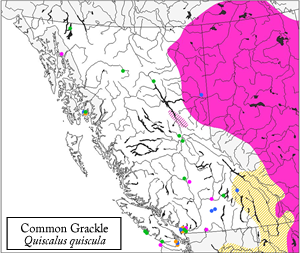The identification of both sexes is relatively straightforward due to their size and long tail, although several other species of blackbirds can appear superficially similar. Male Brewer’s Blackbird is distinguished from adult Common Grackle by its smaller size, shorter, square-tipped, and unkeeled tail, and smaller, less imposing bill. As well, the body of the male Brewer’s Blackbird is heavily glossed with green or bluish-green, whereas that of the male Common Grackle is glossed with bronze. Juvenile Common Grackles have dark eyes and are brownish, like female Brewer’s Blackbird, but can still be easily identified by their larger size and distinctive tail shape. Male Rusty Blackbird can be differentiated from Common Grackle by many of the same characteristics as the Brewer’s Blackbird (smaller size, shorter square-tipped tail, smaller bill). In addition, the male Rusty Blackbird typically appears all-black in most lights or, at most, shows a relatively faint greenish gloss over the entire head and body (much different from the more distinctive, bronzy and green gloss of Common Grackle). The other Quiscalus species occurring in B.C., the Great-tailed Grackle, is a substantially larger bird than Common Grackle with a significantly larger, longer, and more deeply keeled tail. These two species should not be easily confused.
| The song, which is given by both sexes, is a harsh, squeaky, mechanical readle-eek, sounding like the opening of a rusty gate. The song is sometimes accompanied by a high-pitched, clear whistle, especially in females. Both sexes also give a loud, sharp, deep chuck call as a contact call or when alarmed. Other calls include a harsh, two-noted chitip call given by the female, as well as a variety of other high-pitched whistles and nasal notes. Source: Peer and Bollinger (1997) |
Courtship
Courtship behaviour begins as soon as females arrive on the breeding grounds. Courtship flights typically involve multiple males pursuing a female through the air at various speeds, followed by a variety of displays to the female once she has landed. Displays typically involve the song or other vocalizations, and the displaying males usually extend the feathers of the neck and breast to form a “ruff” during these displays. The male sometimes mates with more than one female during the breeding season.
Nest
The Common Grackle nests both singly and semi-colonially. Nest building begins soon after arrival on the breeding grounds, and is completed primarily by the female over a period of 1-6 weeks. The female often abandons nests part way through construction and moves to a new location, leaving partially constructed nests remaining throughout the area. Conifers are the preferred nesting substrate in most areas, although nests in B.C. have been found in emergent marsh vegetation, riparian willow shrubs, on top of dead snags, in cavities in dead trees, in nest boxes, and on buildings and other structures (bridges, etc.). It has also been known to place its nest in abandoned or occupied raptor (Osprey) and heron nests. Nest heights range from ground level to 16 m, but most nests are within 2 m of the ground. The nest itself is a large (16.5-22 cm outside diameter, 8.5-13 cm inside diameter), loose, bulky cup of twigs, stems, leaves, coarse grass, and other materials (fishing line, trash, cloth, corn husks, bark, feathers, lichen, manure, wire) and is lined with mud, fine grasses, and animal hair.
Eggs
Clutches of (1) 4-5 (7) eggs are laid in mid- to late May or early June, hatching 11-15 days later in mid- to late June. Incubation is done solely by the female. The smooth, glossy eggs are light blue to pale grayish or whitish (occasionally darker brownish, sometimes with a pinkish tinge) and have variable bold dark brown scrawls, blotches, and spots that are concentrated at the larger end of the egg. Some eggs lack any markings. This species is sometimes double-brooded, but most B.C. populations likely produce only a single clutch each year. This species is an infrequent host for Brown-headed Cowbird parasitism.
Young
The young remain in the nest for (10) 12-15 (17) days following hatching, with nestlings present in B.C. between mid-June and mid-July. Nestlings are altricial and downy, with pale brown down. After fledging, the young remain around the nest for 1-3 days before dispersing, after which time they are tended by both parents for several weeks. Juveniles join mixed flocks with adults during July.
Source: Baicich and Harrison (1997); Peer and Bollinger (1997); Campbell et al. (2001)
|
The Common Grackle is a very opportunistic feeder and consumes a wide variety of animal and plant material. The Common Grackle feeds on insects (beetles, caterpillars, grasshoppers, etc.) and vegetation (seeds, grains) during the breeding season, but focuses on grains and fruits during migration and winter. It is particularly fond of corn in agricultural areas, and often associates with other blackbirds and starlings to feed in areas of spilled grain. This species forages on seeds, insects, and even small fish along the edges of wetlands during the breeding season, often wading into shallow water. It sometimes kills small mammals (mice, etc.), small birds, and nestlings and will rob nests of eggs. In residential areas, it commonly scavenges refuse and bits of food in parks and suburbs.
Source: Peer and Bollinger (1997)
|
|

